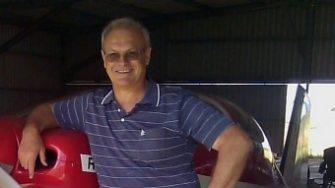Introducing Alumnus: Phil Anderton
Read our latest alumni profile featuring Associate Professor Phil Anderton whose love of physics and optics, led him to a career in Optometry
Read our latest alumni profile featuring Associate Professor Phil Anderton whose love of physics and optics, led him to a career in Optometry

Name: Phil Anderton
Class of: 1970
Degree: BOptom, MSc, PhD
Short Biography:
Phil Anderton has been interested in eyes, optics and vision since childhood. This interest was augmented by his first experience at an optometrist in 1964, aged 14, where he was fascinated and converted by personally experiencing the clinical tests used by optometrists to measure vision and optical refraction. He decided to become an optometrist when he put on his first spectacles for myopia and saw the World clearly for the first time. He graduated in Optometry in 1970, completed MSc and PhD degrees and was appointed to the UNSW Optometry staff in 1978. He has published research in the areas of visual ergonomics, retinal physiology and pharmacology, tearfilm rheology and biochemistry, and the socioeconomics of rural healthcare access in Australia. He has served in various capacities advising State and Federal Governments on the Optometry profession, Glaucoma and Rural Eye and Vision Care. He was a foundation member of the Board of the CRC for Eye Rerearch and Technology where he developed an innovative system of postgraduate review. He was responsible for introducing postgraduate education in Ocular Therapeutic prescribing in UNSW Optometry in the 1990s.
Why did you choose to study Optometry?
In 1964, aged 14, I complained to my parents that things were blurred, and at school I couldn’t read the blackboard. This all changed when Newcastle optometrist John F. Miner gave me my first examination. All the tests seemed like magic to me, especially the phoria, duochrome and fan/block astigmatism tests. My decision to become an optometrist came when I donned my new -0.75 DSOU spectacles and first saw the leaves on distant trees. My favourite subject at School was Physics and the favourite topic was optics. The magic of a real inverted image formed by a positive lens still fills me with wonder.
What was your experience being an Optometry student?
There were five of us, all Anglo males. First year was a common Science year with Maths, Physics, Chemistry and Biology. In years 2-4, all the optics and optometry subjects, and the clinics, were taught at the Technical College building in Mary-Anne street Ultimo. My favourite subjects were ophthalmic Anatomy and Physiology, and Optics.
After graduating, how did your career path evolve?
I was a travelling rural optometrist for Gibb and Beeman (now incorporated into OPSM) for two years. I then pursued an academic career researching visual psychophysics, retinal mechanisms of adaptation, and retinal single-cell neurophysiology and pharmacology. I was appointed a full-time Academic staff member of the UNSW School of Optometry in 1978 and retired in 2005.
What are your proudest achievements, both professional and/or personal?
With colleagues Professor Tom Millar at UWS, and Professor Murray Fingeret from SUNY, I put together the original postgraduate MOptom course in ocular therapeutics in 1995. This was subsequently expanded and developed by Professor Fiona Stapleton. It was demanded by our rural optometrist colleagues and has developed into a major new direction for the optometry profession in NSW.
When I retired, I built a light aircraft (see photo) and used it to travel to remote Indigenous communities to deliver optometry clinics. It was an honour to serve these communities, and to have been virtually adopted as one of the local mob.
Do you have any advice for school leavers considering studying Optometry at UNSW Sydney?
Any Tertiary student in any discipline needs to research their career options carefully. At UNSW, students must first complete a Bachelor of Vision Science, and some may not gain entry into the Clinical Optometry course, now offered at Master’s level.
The Vision Science degree offers excellent experience in the discipline, and prospective students should research options in both Science and Clinical Optometry. There is a definite need to create options to support rural students who wish to return home to practice. There are rural shortages in all health disciplines, including Optometry.
Please share any fond memories you have of your time studying at UNSW Sydney.
In 1968 there were five of us in year 3 of the Bachelor of Optometry course, and two of us were studying “Music” as a General Studies elective. As a part of this, we were required to listen to music in a room where vinyl records were stored and played to be heard by students through headphones. We were listening to Beethoven’s 7th Symphony and, as a result were late for a bus to take us to Ultimo for a lecture by Dr Jack Alexander. He asked us why we were late. Our response was that we were listening to a Beethoven Symphony and just had to hear it all the way through. Dear Jack, who is a brilliant musician, just said: “I can’t argue with that”. We sat down and the lecture commenced.